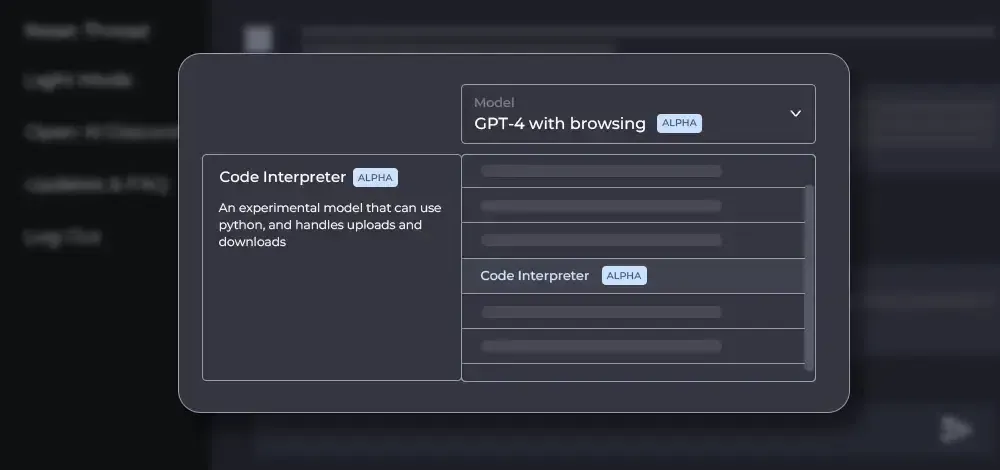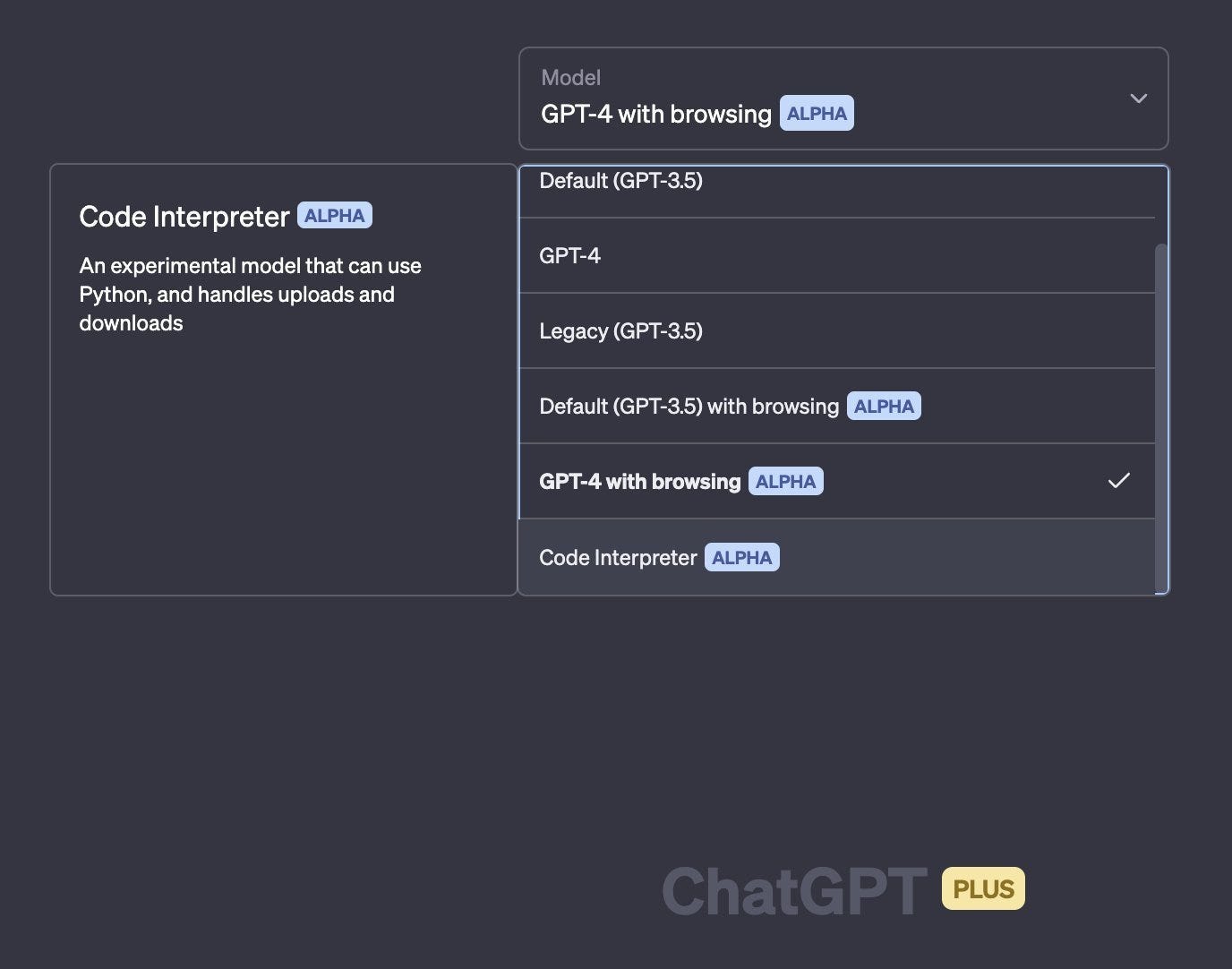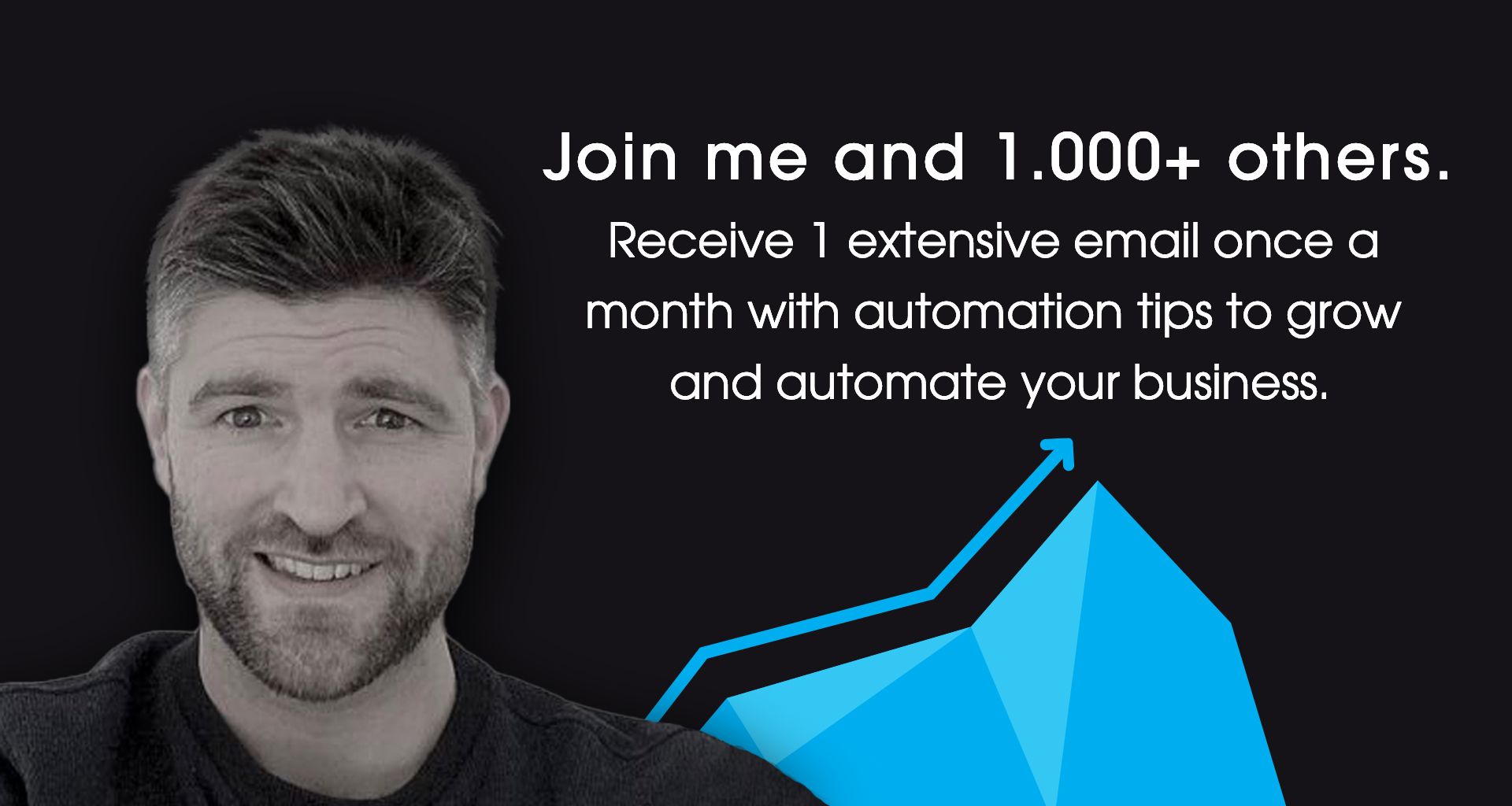Code Interpreter ChatGpt for Marketing Automation: How to use it effectively
Marketing automation has revolutionized the way businesses interact with their audience, streamlining repetitive tasks and optimizing campaign workflows.

Integrating a code interpreter, such as the ChatGPT code interpreter, within marketing automation opens up new avenues for efficient and intelligent automation.
By incorporating the code interpreter, marketers can communicate with their automation system using nCode Interpreter for Marketing Automation: How to use it effective natural language queries. This allows for more intuitive and expressive interactions, eliminating the need for rigid syntax and complex coding. Marketers can effortlessly trigger campaigns, generate reports, and execute tasks through simple, human-like requests.
The code interpreter's versatility extends beyond traditional marketing tasks. It can be utilized for NLP-Based Marketing Automation, such as sentiment analysis, text summarization, and content generation. This enables marketers to analyze customer feedback, create engaging content, and craft personalized responses, all within the marketing automation ecosystem.
Also, the code interpreter's ability to integrate external APIs and libraries empowers marketers to access various services and functionalities without leaving the automation platform. From fetching real-time data to automating social media interactions, marketers can leverage a diverse set of tools to enhance their campaigns.
These are just a couple of simple examples of using the ChatGPT code interpreter, but time-saving is also one of them.
Time Saver with Use The Code Interpreter ChatGPT
The time-saving benefits of using the code interpreter within marketing automation are pretty clear and obvious. With more intuitive interactions, marketers can efficiently set up, monitor, and optimize their campaigns, reducing manual efforts and increasing productivity. The interpreter's dynamic and interactive nature allows marketers to make real-time adjustments, improving campaign responsiveness and effectiveness.
Moreover, the code interpreter enables marketers to automate complex processes that previously required manual intervention. By utilizing NLP and external APIs, marketing automation becomes more sophisticated and agile, saving lots of valuable time and resources. And in the end, that's what we are looking for when we start automating stuff.
Integrating the ChatGPT code interpreter into marketing automation holds immense potential. Through natural language queries, marketers can interact seamlessly, automate tasks, and access external services, streamlining campaign management and maximizing productivity. It really paves the way for more efficient, data-driven, and personalized marketing experiences. Let's dive a bit deeper.
The Power of Code Interpreter ChatGPT in Marketing Automation
In the dynamic marketing world, staying ahead of the competition requires efficiency, automation, and intelligent decision-making. As businesses strive to engage with their audience effectively and deliver personalized experiences, integrating cutting-edge technologies becomes imperative. The advent of code interpreters like that of ChatGpt in marketing automation heralds a new era of streamlined workflows and time-saving benefits for marketers.
Below I dive into what the interpreter is, to understand it a bit better, and how the code interpreter can save massive amounts of time, without making it too technical by giving some practical use cases.
Embracing The Code Interpreter ChatGpt : An Introduction
The code interpreter, made by ChatGPT, is an advanced language model that understands human-like language and processes natural language queries. In marketing automation, this means transcending the barriers of rigid syntax and complex coding, enabling marketers to interact seamlessly with their automation systems. Using natural language, marketers can trigger campaigns, generate reports, and execute tasks easily and quickly.
The Code Interpreter ChatGpt Power of Marketing Automation
Marketing automation, on the other hand, empowers businesses to automate repetitive tasks, segment audiences, and deliver targeted content, thereby saving valuable time and resources. However, traditional automation often requires developers to write code and adhere to specific syntax. With the code interpreter, marketers gain an innovative approach that simplifies their interactions, driving greater productivity.
The Best Intersection of Code Interpreter ChatGPT and Marketing Automation
The seamless integration of the ChatGPT code interpreter plugin with marketing automation platforms opens a world of possibilities. Marketers can communicate with the system naturally, receiving dynamic and interactive responses. Whether it's triggering email campaigns, conducting sentiment analysis on customer feedback, or managing content personalization, the code interpreter brings huge efficiency to marketing tasks.
Code Interpreter ChatGPT Your Time-Saving Tool
Time is a precious commodity in the fast-paced marketing landscape. As marketers can streamline processes and make real-time adjustments, it boosts campaign responsiveness. The interpreter's ability to integrate with external APIs and libraries enhances data access and empowers marketers to automate complex tasks without manual intervention. The result is more time for strategic decision-making and creative imagination.
In this convergence of code interpreting and marketing automation, marketers gain a powerful tool to drive results and optimize their efforts. The ability to communicate through natural language and access a vast array of functionalities presents a competitive edge. Increased productivity and more customer engagement is the goal of marketing going forward, and the code interpreter is a good tool to contribute to this goal.
The example below is a fairly simple prompt that you can give as input to run a data analysis on lead data you have. It even gives you the step by steps what to do from scratch to get the data you want.
Integrating Code Interpreter ChatGpt in Marketing Automation
In this chapter, I will walk you through the process of integrating the ChatGPT code interpreter into marketing automation, discovering how it revolutionizes marketers' interactions and empowers them to deliver personalized experiences with lots of time-saving benefits.
First of all, marketers should start by understanding the fundamentals of the code interpreter and its natural language processing abilities. Accessing the ChatGPT API and setting up the development environment lays the groundwork for seamless interactions with the interpreter.
To ensure a smooth integration, marketers should focus on secure API authentication, efficient API calls, and robust error handling. By harnessing the power of external AI services, marketers can achieve hyper-personalization and implement location-based marketing strategies. A/B testing automation and email marketing optimization further enhance campaign effectiveness.
With real-world applications and use cases, and there are many (see below) , marketers witness the potential of integrating the code interpreter with external resources. Its integration is a gateway to enhanced efficiency, data-driven decision-making, and personalized customer experiences.
Some use cases can be:
- Campaign Triggering: Automate the scheduling and triggering of marketing campaigns based on user interactions, events, or predefined conditions, all through natural language queries.
- Content Personalization: Dynamically deliver personalized content, such as website recommendations, email newsletters, and product offers, based on user preferences and behavior.
- Sentiment Analysis: Analyze customer feedback and sentiment through natural language queries, enabling marketers to understand customer emotions and improve customer experiences.
- Real-time Analytics: Access real-time data from various sources, including website traffic, social media engagement, and ad performance, to make data-driven decisions promptly.
- Social Media Automation: Automate social media interactions, such as posting updates, responding to messages, and analyzing social metrics, to streamline social media management.
- Hyper-personalization: Leverage machine learning APIs to create predictive models and segment audiences effectively, enabling hyper-personalized content recommendations and targeted advertising.
- Image Recognition: Analyze visual content through image recognition APIs to optimize image assets, identify user-generated content, and ensure consistent branding.
- A/B Testing Automation: Automate A/B testing processes to compare variations in marketing campaigns and determine the most effective strategies.
- Location-based Marketing: Implement location-based marketing strategies using geolocation APIs to target specific audiences based on their geographical locations.
- Email Marketing Optimization: Optimize email campaigns through email marketing APIs, automating email scheduling, analyzing engagement metrics, and improving deliverability.
- Customer Support Automation: Automate customer support interactions, such as answering frequently asked questions and providing personalized responses, using the code interpreter.
- Lead Scoring: Implement lead scoring models to assess lead quality and prioritize follow-up actions, integrating the code interpreter with external AI services.
- Content Generation: Use the code interpreter to generate creative and engaging marketing content, such as blog posts, social media captions, and product descriptions.
- Competitive Analysis: Utilize natural language queries to gather data on competitors' marketing strategies, pricing, and customer sentiment to inform your own marketing decisions.
- Multi-channel Marketing Orchestration: Automate multi-channel marketing efforts, coordinating campaigns across various platforms, including email, social media, and website, for a consistent brand experience.
- Event-based Marketing: Implement event-based triggers and automation, enabling timely and relevant customer interactions based on specific events or milestones.
- Predictive Customer Segmentation: Leverage machine learning algorithms to segment customers based on their behavior, preferences, and purchase history, enabling targeted marketing strategies.
- Real-time Customer Feedback Response: Respond to customer feedback and queries in real-time, enhancing customer satisfaction and building stronger brand relationships.
- Abandoned Cart Recovery: Automatically trigger personalized follow-up emails or messages to recover abandoned carts, increasing conversion rates and revenue.
- Performance Monitoring and Reporting: Automate the generation of performance reports and marketing analytics, providing valuable insights for optimizing future marketing strategies.

Marketing tools that work well with Code Interpreter ChatGpt
The Code Interpreter works well with almost any marketing automation tool. Let me give you five practical examples of marketing automation tooling and why you should consider combining these with ChatGPT and the interpreter.
1. HubSpot
Why it works well: HubSpot's all-in-one marketing suite offers excellent segmentation, lead scoring and personalization features. The integration with GPT allows for creating highly personalized content and automatic segmentation of leads based on interactions and preferences.
Practical example: Imagine a business selling eco-friendly products. By integrating GPT with HubSpot, they can create personalized emails that offer product recommendations based on each user's past purchases and preferences. For example, a user who has purchased reusable water bottles might receive an email showcasing eco-friendly cleaning products with a personalized message generated by GPT, enhancing user engagement.
2. Marketo
Why it works well: Marketo's robust tracking and analytics tools enable a business to understand its audience's behavior and preferences. GPT's language capabilities allow for crafting tailored content that resonates with different segments.
Practical example: A SaaS company can integrate GPT with Marketo to create dynamic landing pages that adapt to the user's industry, role, or interests. If a user in the healthcare sector visits the site, GPT can generate content specific to healthcare applications of the software, ensuring relevance and increasing the conversion rate.
3. Salesforce Marketing Cloud
Why it works well: Salesforce Marketing Cloud has strong CRM capabilities and integrates seamlessly with sales processes. GPT can enhance customer journeys by offering personalized content at every stage.
Practical example: A travel agency integrates GPT into Salesforce to send personalized travel suggestions to clients based on past travel history and preferences. For a client who enjoyed a skiing trip, GPT could craft a personalized offer for a summer mountain hiking package, seamlessly connecting past interests with future opportunities.
4. Pardot
Why it works well: Pardot specializes in B2B marketing and has powerful lead management features. Integrating with GPT enables more personalized and effective lead nurturing.
Practical example: A B2B tech company uses GPT within Pardot to create personalized video scripts for potential clients. These scripts consider the potential client's industry, pain points, and the specific solution offered. The result is a custom video pitch that resonates closely with the client's unique needs.
5. Active Campaign
Why it works well: ActiveCampaign excels at customer experience automation, combining email marketing, automation, sales automation, and CRM. The synergy with GPT allows for highly personalized multi-channel experiences.
Practical example: An online fashion retailer integrates GPT with ActiveCampaign to personalize not only emails but also website experiences. If a customer recently browsed winter coats, GPT can craft a personalized follow-up email with coat recommendations and modify the website's home page to highlight similar products during the customer's next visit.
Code Interpreter ChatGpt Mastering Content Personalization and Segmentation: A Step-by-step
Using the ChatGPT Code interpreter for personalization is something that can be super valuable since everything about customer and lead interaction in the future will evolve around personalizing your messaging. The ChatGTP Code interpreter is able to do this, but where to start? Let me give you a concrete list of steps to take when you want to use the code interpreter for, as an example, content personalization.
Step-by-step example 1: content personalization
Step 1: Obtain Access to the Language Model API. Sign up for API access to the language model. This might require registering with an AI provider like OpenAI or any other platform offering language model services.
Step 2: Get API Credentials. After registration, you will receive API credentials, including an API key or token. Keep these credentials secure as they grant access to the language model.
Step 3: Set Up Development Environment Prepare your development environment by installing any required libraries or SDKs provided by the API. For example, OpenAI offers a Python library called "openai" to interact with their GPT-3 language model.
Step 4: Authenticate with API Using the API credentials obtained earlier, authenticate your application to make API calls securely.
Step 5: Craft a Content Personalization Query For content personalization, structure a natural language query or prompt to the language model, describing the personalized content you want to generate. Include any relevant context or user information to make the content more tailored.
Step 6: Send the Query to the Language Model. Make an API call to the language model, passing your content personalization query as input.
Step 7: Receive and Process the Model's Response. The language model will respond with personalized content generated. Process the response as needed, extracting the relevant parts for use in your marketing content.
Step 8: Integrate the personalized content into your marketing automation platform or website. This might involve updating email templates, website content, or social media posts, depending on your marketing channels.
Step 9: Test and Optimize Test the personalized content to ensure it aligns with your marketing goals and resonates with your audience. Continuously monitor performance and optimize the generated content to improve its effectiveness.
Step 10: Monitor API Usage and Costs. Keep track of your API usage to manage any usage limitations or costs associated with the language model service.
Remember that the specifics of using a language model for content personalization may vary based on the API provider and the particular model you are using. Always refer to the official documentation and guidelines provided by the language model's developers for the most accurate and up-to-date information on usage and best practices.

Another practical step-by-step example that the ChatGPT Code interpreter can help you with is around the topic of lead scoring and segmentation. This can look like this:
Step by step example 2: Segmentation
Step 1: Obtain Access to the Language Model API Just like in the previous example, sign up for API access to the language model you wish to use for lead scoring and segmentation.
Step 2: Get API Credentials Upon registration, you'll receive API credentials, such as an API key or token, required for authentication.
Step 3: Set Up Development Environment Prepare your development environment by installing any necessary libraries or SDKs provided by the language model's API. Ensure your programming language and environment are compatible with the API.
Step 4: Authenticate with API Using the API credentials obtained earlier, authenticate your application to make secure API calls.
Step 5: Prepare Lead Data and Context. Gather and organize the lead data you wish to score and segment. This data may include lead demographics, behavior, engagement, and any other relevant information. Additionally, provide context or instructions to the language model about the criteria and attributes you want to consider for scoring and segmentation.
Step 6: Create a Query for Lead Scoring. Formulate a natural language query or prompt for the language model, describing the lead scoring criteria you want to apply. Include specific lead attributes, scoring rules, and any other relevant factors.
Step 7: Send the Query to the Language Model, make an API call to the language model, and pass your lead scoring query as input.
Step 8: Receive and Process the Model's Response. The language model will respond with lead scores or segmentation recommendations based on the provided criteria. Extract and process the relevant information from the response.
Step 9: Implement Lead Scoring and Segmentation Integrate the lead scores and segmentation recommendations into your lead management system or CRM (Customer Relationship Management) platform. Use this data to categorize and prioritize leads based on their scores and segments.
Step 10: Test and Optimize Test the lead scoring and segmentation results to ensure they align with your business goals and effectively identify high-potential leads. Continuously monitor the performance and fine-tune the scoring criteria to optimize lead management.
Step 11: Monitor API Usage and Costs. Keep track of your API usage to manage any usage limitations or costs associated with the language model service.
Using a language model for lead scoring and segmentation can enhance your lead management process by automating the evaluation and categorization of leads based on various attributes and criteria.
In Conclusion
As you can see, ChatGPT´s code interpreter can be used for various marketing automation tasks and save you a massive amount of time. Of course, it needs investing before you can reap the fruits. But the possibilities are really endless.
FAQ:
Q1. What is the ChatGPT code interpreter, and how can it benefit marketing automation?
The ChatGPT code interpreter is an advanced language model that enables natural language queries within marketing automation. It eliminates the need for complex coding, allowing marketers to trigger campaigns, generate reports, and execute tasks through human-like requests, streamlining efficiency and effectiveness.
Q2. What are some practical use cases of integrating the ChatGPT code interpreter with marketing automation?
Practical use cases include campaign triggering, content personalization, sentiment analysis, real-time analytics, social media automation, hyper-personalization, image recognition, A/B testing automation, location-based marketing, email marketing optimization, customer support automation, lead scoring, content generation, competitive analysis, and more.
Q3. How does the ChatGPT code interpreter work with popular marketing automation tools like HubSpot, Marketo, and Salesforce Marketing Cloud?
It enhances these tools by enabling personalized content generation, dynamic landing pages, CRM integration, and customer journey personalization, resulting in more effective lead nurturing and customer engagement.
Q4. Can you provide a step-by-step guide for content personalization using the ChatGPT code interpreter in marketing?
- Step 1: Obtain API access.
- Step 2: Get API credentials.
- Step 3: Set up development environment.
- Step 4: Authenticate with the API.
- Step 5: Craft a content personalization query.
- Step 6: Send the query to the language model.
- Step 7: Receive and process the model's response.
- Step 8: Integrate personalized content.
- Step 9: Test and optimize.
- Step 10: Monitor API usage and costs.
Q5. How can the ChatGPT code interpreter be used for lead scoring and segmentation in marketing automation?
It can be utilized for lead scoring and segmentation by:
- Gathering lead data and context.
- Creating a lead scoring query.
- Sending the query to the language model.
- Receiving and processing the model's response.
- Implementing lead scoring and segmentation.
- Testing, optimizing, and monitoring API usage for ongoing improvements.
Subscribe for video explainers and more use cases.
Do you want to receive video examples and practical walk-through explainer videos? Just sign up for my newsletter on the bottom or top right. I will dive into this subject on a much deeper level in many of the monthly newsletters I send out every last Saturday of the month.

